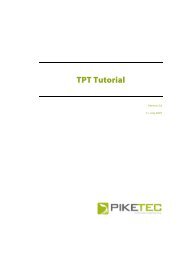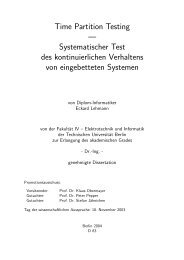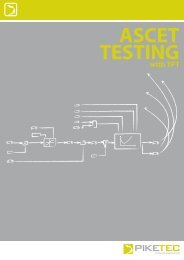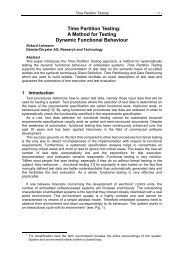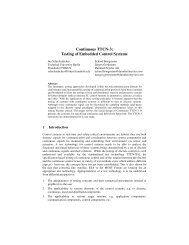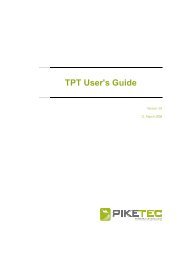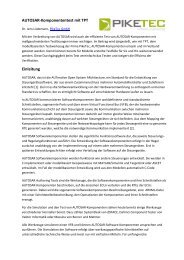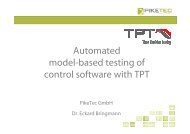TPT User's Guide - PikeTec
TPT User's Guide - PikeTec
TPT User's Guide - PikeTec
You also want an ePaper? Increase the reach of your titles
YUMPU automatically turns print PDFs into web optimized ePapers that Google loves.
<strong>TPT</strong> <strong>User's</strong> <strong>Guide</strong> Page 41<br />
9 Platform configuration<br />
9.1 Introduction<br />
<strong>TPT</strong> test cases are modelled independent of the execution platform. This means <strong>TPT</strong> test cases<br />
can be executed in different execution environments. Each platform needs different<br />
configurations in order to execute simulations.<br />
In order to execute the tests the test platform has to be configured. The test platform is the<br />
execution or simulation environment (e.g. Model in the loop (MATLAB/Simulink), standalone,<br />
executable file or HiL). The specifics of the environment need to be specified in the platform<br />
configuration.<br />
E.g. the MATLAB platform requires information which Simulink-model file is used while HiLconfigurations<br />
need information how signals at the HiL are mapped. For that reason for each<br />
platform there exists a platform configuration.<br />
Sometimes it makes sense to have different configurations for one physical platform. By doing<br />
this a system under test can be tested in different environments like Model in the loop (MiL) or<br />
Software in the loop (SiL).<br />
9.2 Selecting the platform<br />
Open a platform configuration window using execution | platform | add and select<br />
the platform from the given list.<br />
9.3 MATLAB/Simulink environment<br />
One possible test execution configuration is implemented in MATLAB/Simulink. The test<br />
execution engine (<strong>TPT</strong> Virtual Machine (VM) is implemented as an S-function in Simulink<br />
(see Simulink S-function documentation). The S-function passes the values calculated by the<br />
system under test (SUT) to the <strong>TPT</strong> execution engine. For each time step all outputs of the SUT<br />
are inputs to the <strong>TPT</strong> VM. Thus all values that are needed for the test execution need to be<br />
declared as inputs in <strong>TPT</strong> and all <strong>TPT</strong>-outputs are inputs into the SUT. The interface of the <strong>TPT</strong>-Sfunction<br />
is defined by the channel declaration of the <strong>TPT</strong> testlet.






